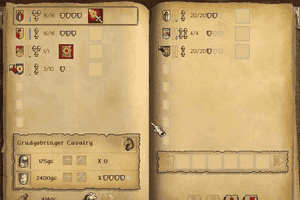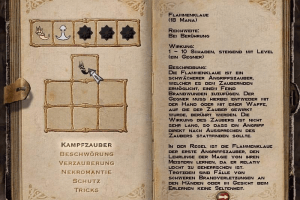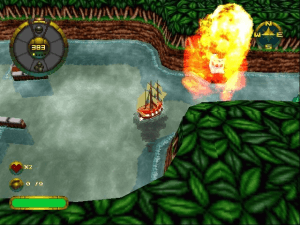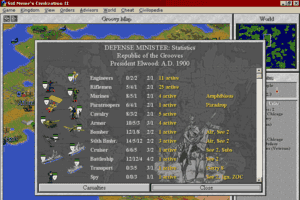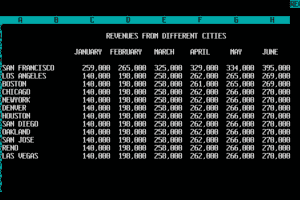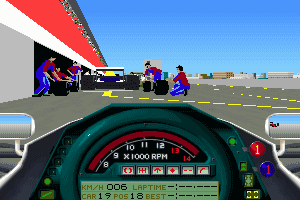Sabre Ace: Conflict Over Korea
Windows - 1997
Description of Sabre Ace: Conflict Over Korea
When you think about it, it's surprising that there hasn't been more flight sims with the Korean war as their subject. That conflict saw the last example of what I would call the classic air war, one where missiles and beyond visual range kills played no part and the dogfights were up close and personal.
Another intriguing feature is that for once the good guys had inferior equipment to the enemy. The F86 Sabre was a classic fighter, no doubt about it but early versions were inferior to the Mig 15s they encountered both in performance and firepower. With that in mind, the achievement of the Sabre pilots in shooting down 11 Migs for every Sabre lost seems incredible. The Korean war was also the only air war I can think of where jet and propeller engined aircraft mixed to any great extent. A heady brew indeed.
The only previous title to feature the Korean conflict is Air Warrior in its various incarnations which came with a flyable Sabre and Mig 15 and a few scenarios to fly them in. Now, as is so often the case with buses and software titles we have two coming along at once, Sabre Ace -Conflict over Korea from Virgin which we're looking at here and coming soon, Mig Alley from Rowan
Graphics
Sabre Ace supports the usual wide range of 3d accelerator graphics cards and as you might expect, using these cards the game looks great. The aircraft models in particular are worthy of mention, accurately capturing the colourful paint schemes of aircraft of the time. The landscape graphics are good too although the join between two tiles of the landscape texturing is sometimes visible. i was also somewhat surprised to see that the rivers accurately follow the contours of the hills, up and down. I'm not sure what the graphics look like without the benefit of a 3d card because I was unable to persuade it to ignore my 3dfx card. The game runs smoothly most of the time on my P200 though there can be delays as new textures or whatever are loaded in. This is especially noticeable when encountering the enemy for the first time. Still, I only have a barely adequate 16M of memory in my machine (grinds teeth).
Back to Training
Sabre Ace allows the player to take on the role of a US or North Korean pilot and fly through a series of canned missions. As their experience increases, the player will find themselves at the helm of increasingly capable aircraft, the North Korean pilot moving from a World War II vintage Yak 9 to the Mig 15 and the US pilot graduating from the F51 (as it was during the Korean conflict) to the F80 Shooting Star and finally the F86 Sabre. There are not the only aircraft the player can fly though because unusually, Sabre Ace contains a training section with its own aircraft where the rookie can fly the T6 Texan, the T33 or on the communist side the Yak 18 and Mig15 UTI, a two seater variant of the Mig 15. At least that's supposed to be the case.
The training lessons are on the main well done. The early circuit and navigation exercises come with an instructor in the back seat who will tell you what course to follow and will warn you if you are getting low or slow. More usefully, in the circuit lesson you are the second aircraft in a flight of two and following your leader and obeying your instructor's prompts is a great way to find out what you should be doing at various parts of the circuit.
Sadly though, the strain of putting his life into the hands of incompetent rookies every day has obviously told on your instructor because sometimes he can be a bit inconsistent. Let your attention wander and your command drift a bit close to the ground and your instructor will snatch back control of the plane (an excellent feature I thought) and snarl "Are you trying to kill us both?" Then as soon as the plane is back up to a respectable altitude and you have resumed control than he announces "You're really getting the hang of this". Either he's trying to boost your confidence or he's got a really bad memory.
This may be however a cunning plan on his part to wreck the competence of your air force for I have reason to believe that the Russian and the US instructor are one and the same person! It is noticeable that the Russian instructors accent occasionally wavers off course into a transatlantic twang. They even say the same things during the flight. Someone inform the KGB/CIA (delete as applicable)!
There are four types of training mission, the circuit familiarisation as mentioned above, a navigation exercise which sees you following various landmarks such as rivers and bridges before joining up with another pupil for some formation flying home and two combat exercises, ground attack and air to air.
Sabre Ace features a number of surprise packages for delivery to the poor pongos, rockets, bombs and (another first for Sabre Ace I think), napalm. On the attack run, the pilot must make sure that all his switches are set correctly so that the desired ordinance will come off the racks. They must also make sure that the correct sight has been selected since the aircraft in Sabre Ace have three, one for gunnery, one for rockets and one for bombs.
Air to ground training is done over a nearby firing range and after each pass, the observers on the ground will let you know how close you came to the target. Thankfully there is a facility for rearming in mid air so you don't have to trail all the way back to your airfield to try and better your score.
The range observers will be recording a lot of misses unless you pay close attention when reading the preflight briefing on the parameters for weapon release. Unless you stick closely to the recommended speed and angle of attack, your ordinance won't be going anywhere near where your sight is pointing. Such realism is refreshing.
In air to air combat training, the eager pilot can choose to fly any flyable aircraft in the game against any opposition they like including aircraft on the same side. This gives you a chance to blast away at defenceless bombers before taking on the big boys. Sadly, the feedback from this section isn't as comprehensive as that from the air-to-ground training.
So to Battle
The idea behind Sabre Ace is that you are following the career of a pilot in Korea and so you will fly a number of missions before you are retired, shipped home in a box or whatever. Unfortunately, there doesn't seem to be any variation in these missions, There is no dynamic campaign or even a campaign tree with different branches to go down. The rookie pilot starts off flying the lowest of the low their airforce possesses, the F51 in the case of the USAF or the Yak 9 for the commie and after so many missions graduates to more potent machinery, the F86 (via the F80) for lovers of mom's apple pie and the Mig 15 for lovers of mom's apple vodka.
The presentation of the missions is well done with maps, written briefings and even recon photos being available for perusal before the flight. It is a sign of the detail involved that amongst the information given is the bail out area for those hoping to avoid capture after being shot down and alternative airfields should you find yourself unable to make it home. All the briefing information is also available during flight with a brief glance at your kneepads
In the air, the presentation maintains its good quality with plenty of radio chatter to keep you amused. It was a bit of a waste of time getting all those recon pictures because once you get to the strike area, it's obvious what the target is, it's the area that looks different to the rest of the landscape because it actually has buildings on it.
One very impressive feature is the anti-aircraft fire. You can hear the explosions in your cockpit and see the puffs of black smoke floating past you. If you are unlucky enough to actually get caught by one of these explosions, you can see the damage to your aircraft in the way of holes in the wings and tail.
There are some puzzling things about the missions though, some things which don't quite add up. For instance in one of the F51 missions, you are required to escort a transport in which General MacArthur is returning to Korea. Could you resist? In a trice I was on the general's 6 letting him have it with all 6 50 cals. The starboard inner engine of the transport started belching flame most satisfactorily (I had been hitting the fuselage but never mind). Then a message came over the radio, something along the lines of "The general's plane went in boys. He didn't make it." All very heart rendering except that I was about 50ft. from the transport and it was still flying as far as I could see. Loath to make the radio guy a liar, I continued my assault but the pilot must have managed to get his shields up because I couldn't knock that C54 down, no matter how many times I tried. Eventually the transport flew into the side of a hill and put us all out of our misery.
Do not think that I got off scot free with this mischievous prank though. Nope, I was reprimanded for shooting down the supreme commander. Military discipline eh?
In the cockpit, the pilot will find a wide range of accessories ready to assist them. For those long boring bits of the flight, there is an autopilot which will maintain the current heading and altitude, For the lost, there is an adf dial which will point the way to any of the airfields mentioned in the mission briefing. For the warlike, there is an instrument which will point towards any aircraft within 20 miles. We'll talk a little about this later. Finally and puzzlingly , there is the FDA which I would venture to guess was not present in any original Korea era aircraft. What does this bit of electronic wizardry do? It keeps you in formation with the rest of your flight. Simply tell it what formation you want to fly and who your leader is and the FDA will do the rest. Or nearly anyway. What the FDA does is to fly you to the general vicinity of the correct spot and then leave you to make the final corrections. There are four levels of aid provided by the FDA and quite frankly I'm at a loss as to why it was provided in the game. It would make an excellent training aid for formation flying which might make sense if the game required you to do a lot of formation flying , say on the way to the strike area, but this is almost never necessary because of Sabre Ace's final feature,the zap key.
Remember the early Wing Commander games? (Actually, what I'm about to say might well apply to the later games as well, I stopped playing them after number 2). Remember how after a thrilling bit of space combat, at the mere press of a button, you were sent blasting through space to the next cat fight? Well Sabre Ace has the same feature. Take off, get the wheels and flaps up, press 'Z' and shazam! you're over the target area. Finished the strike? 'Z' again and you're in the circuit. That is unless you've been wounded or your aircraft damaged in which case the zap feature is disabled. Of course such a feature are not new to flight sims, Sierra's Aces series featured it a long time ago and of course you don't have to make use of this feature but for me, it all goes towards making Sabre Ace that bit less serious a sim.
In fact, after playing Sabre Ace for a while I came to the inescapable conclusion that Sabre Ace had been put together with a particular audience in mind and that audience did not include me. I think Sabre Ace is intended for the less dedicated simmer, one who quite fancies the idea of a flight sim but doesn't want to have to worry about energy levels and accelerated stalls. As evidence of this conclusion I present exhibits A and B, the GCI and the flight model m'lud.
The GCI is the magic dingus I mentioned earlier which will provide a heading to any aircraft, friendly or otherwise within 20 miles of your aircraft and will helpfully surround the chosen craft with a luminous green square. The GCI also displays the height and distance of the plane. The game's designers account for this bit of electronic wizardry by explaining that this instrument merely collates the information the pilot would be receiving from ground control radar stations. Good thinking, except that if I remember correctly, one of the problems faced by the Americans over Mig Alley was a lack of ground control radar. However the GCI pales into insignificance when compared with horror that is (ta ta TAHHH!!) the flight model.
Taildragger aircraft are not without their problems. Quite apart from their tendency to chase their own tails on the ground due to the torque generated by the propeller, they by and large offer a hopeless view forward until the tail comes up. One must be careful getting the tail up though because if one is over-enthusiastic about it, the nose will come too far down and the propeller will hit the ground with an expensive crunch. I can testify to how easy it is to do this because it's one of my favourite ways of making a fool of myself in Warbirds (another is to not get the nose down fast enough, veer off the runway and ram a friendly AAA emplacement amidships).
The Sabre Ace pilot has no such problems in his F51, Yak9 or whatever. No matter how hard they shove the stick forward, the nose will never make contact with terra firma. It's like the aircraft are sporting an invisible nose wheel. This effect is even more pronounced on landing where no matter how you haul back on the stick after touchdown, your Yak or F51 is extremely reluctant to let its tailwheel touch the ground. Either the Center of Gravity has shifted during flight or the nosewheel and tailwheel handling models have far too much in common for my liking. The complete lack of torque effects also conspires to make take offs a breeze. I'm beginning to believe that one of the ways the worth of a sim can be judged is in the way its aircraft handle on the ground and by this benchmark Sabre Ace doesn't do very well I'm afraid.
In flight, things are... well I've thought about it and the best I can up with is 'old fashioned'. The Sabre Ace flight model feels like one that would have been found in a sim three or four years ago (Aces over Europe springs to mind for some reason). There is no sense of inertia, move the stick to one side and the plane rolls, center the stick and the roll stops. Instantly. The various aircraft also seem to lose airspeed much less than they should under hard manoeuvring. Sometimes it can be a real effort getting the speed under 100 knots for landing. The fact that extending the flaps and undercarriage seems to have a minimal effect on speed doesn't help.
In my view...
...the views are dire. These days I would have thought that a virtual cockpit was essential for any sim hoping to make it in this mean old world. Sabre Ace dares to be different and provides only a subset of the Air Warrior/Warbirds selection of views, the subset being limited to horizontal all around with an additional 45 degree up view straight ahead and an overhead view. These might be just sufficient for gameplay but for one unfortunate blunder. The views don't overlap (or even join up for that matter) so that when for example a bandit disappears from the bottom of the 45 degree up view, it will be several seconds before it appear in the straight ahead view, always assuming that it hasn't carried out some fantastic evasive manoeuvre while in your blind spot of course.
There is a primitive kind of padlock view which will make sure you are looking in the right direction to follow your target but it too suffers from these blind spots.
Some liberties also seem to have been taken with the pilot's view. Your view ahead is pracically unobstructed by the bulk of the engine when sitting in a taildragger and the rear fuselage decking is also conspicuous by its absence, at least in the F51 where the view of the tail suggests that the pilot is sitting on a parachute 10 ft. thick.
The control panel (which in another stunning break with modern thinking isn't mousable) is split into two sections. In the normal cockpit view, only the more commonly used instruments are visible. A press of a button brings up the entire control panel. Strangely, when you bring up the complete control panel, the outside view changes so that you appear to be looking down at a 45 or so degree angle, rather than looking straight ahead. The cockpit instrumentation is crisp and easily readable
Documentation
The documentation which comes with Sabre Ace is pretty good. The manual is only 73 pages long but it crams a lot of stuff into those pages including a potted history of the Korean War and is lavishly illustrated with screenshots from the game and diagrams. Also good is the separate keyboard reference which comes with a keyboard guide on one side and the key commands grouped by function on the other side. Good stuff.
Bugs and moans
In the training missions, the idea is that you're supposed to prove your ability to get the prop driven aircraft into the air and safely back onto the runway again whereupon you are let loose on the sleek jets. No matter how often I greased my Yak 18 onto the deck though and no matter how many times my instructor told me he was going to let me try it in a jet next time, I never got the option to try out the Mig15 UTI. Shame.
I also had problems in one mission where the game would hang at the same point in the mission each time. This happened three or four times until I eventually managed (quite how, I'm not sure) to get past this point.
Conclusion
Sabre Ace is somewhat of a curates egg which left me uncertain as to which audience it was targetted at. The realism of ground attack and the need for instance to make sure that your cockpit hood is locked open before you ditch all suggest a sim in which some attention has been paid to details the hardcore sim pilot likes to see in a product. On the other hand, the zip feature which allows you to get to the scene of the next action in a hurry, the GCI and the simple flight model all suggests to me that this is a sim more suited for someone looking for a gentle introduction to sims or for an easy ride. As such, it's a pretty good deal. The graphics are good looking, the training exercises are well done and the whole packages is well presented. Hardened simmers looking for a challenge to match the likes of SU27 Flanker might be advised to look elsewhere though.
Review By GamesDomain
External links
Captures and Snapshots
Comments and reviews
Write a comment
Share your gamer memories, help others to run the game or comment anything you'd like. If you have trouble to run Sabre Ace: Conflict Over Korea (Windows), read the abandonware guide first!
Download Sabre Ace: Conflict Over Korea
We may have multiple downloads for few games when different versions are available. Also, we try to upload manuals and extra documentation when possible. If you have additional files to contribute or have the game in another language, please contact us!
Windows Version
Similar games
Fellow retro gamers also downloaded these games:
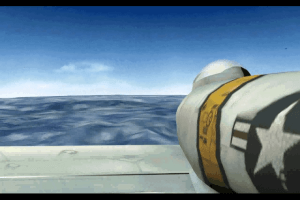
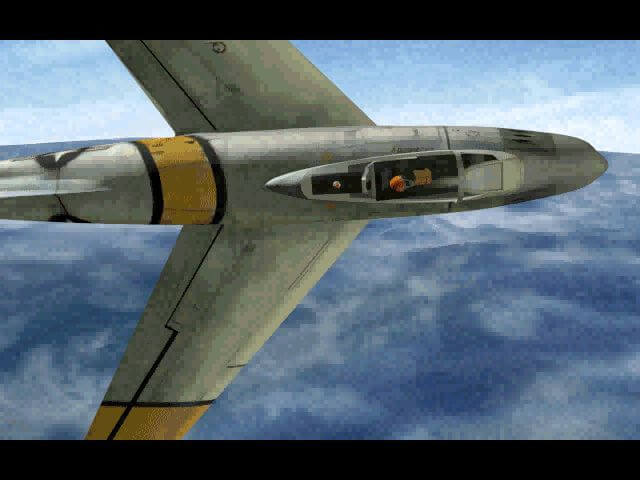
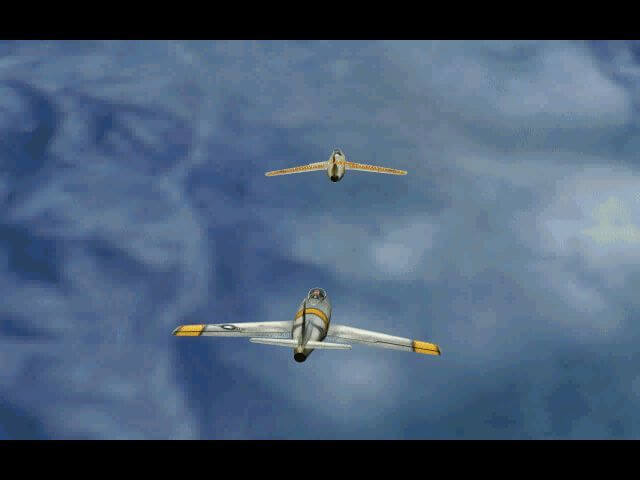
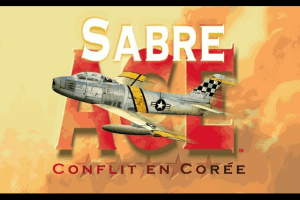
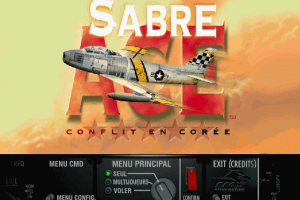
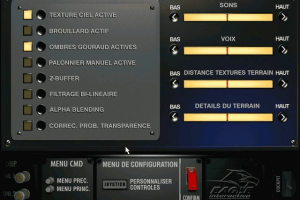
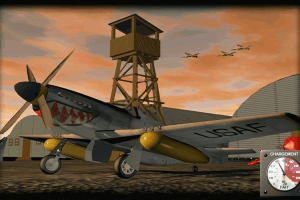
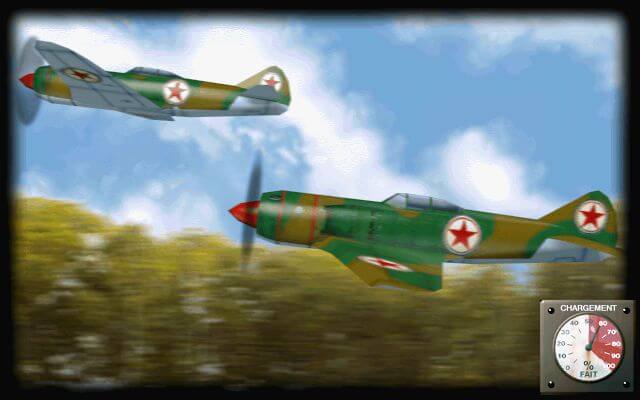
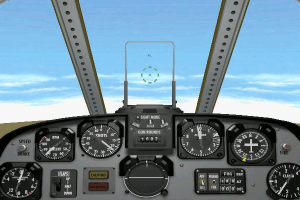

 384 MB
384 MB